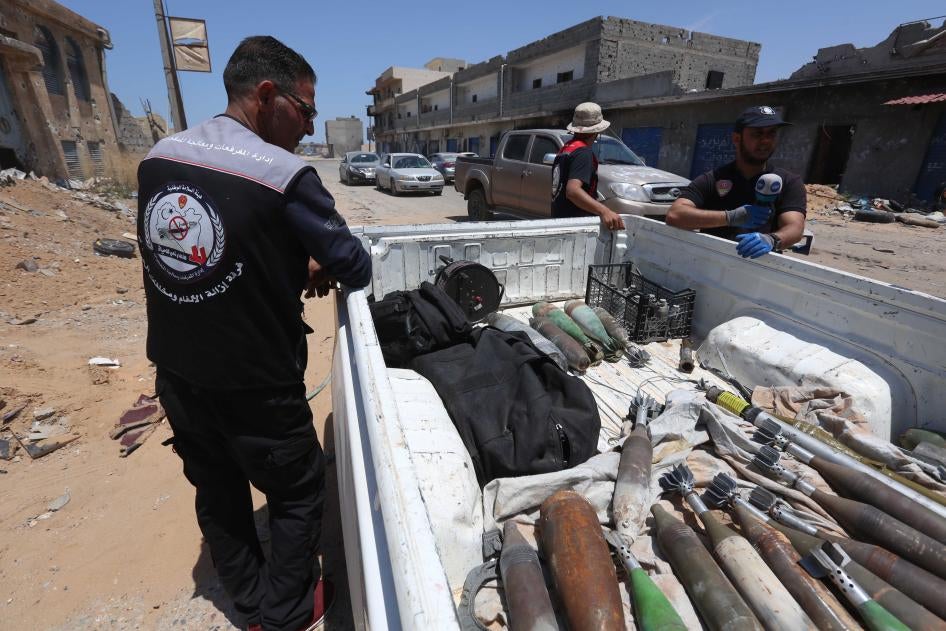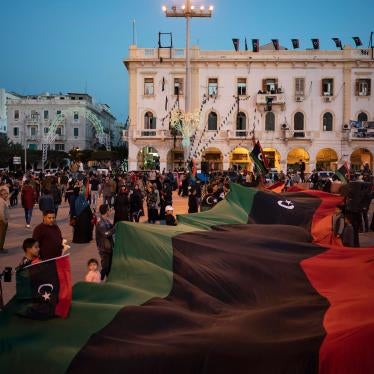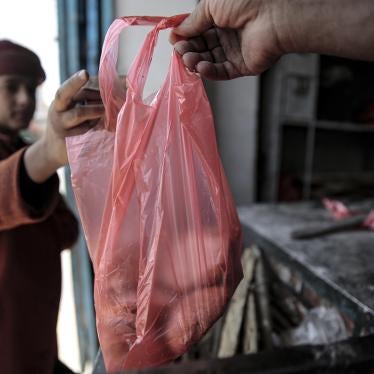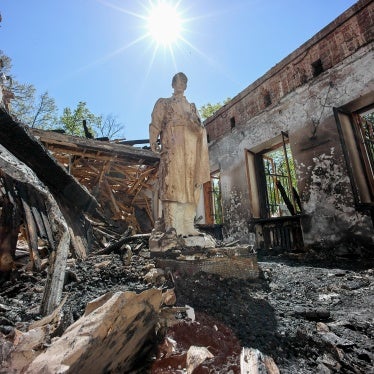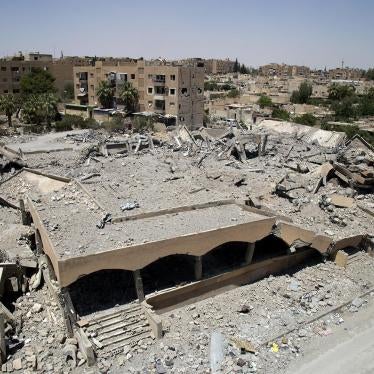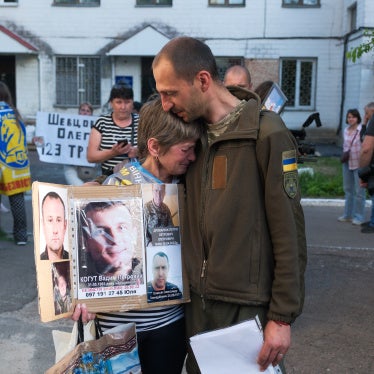(Beirut) – At least 130 people, mostly civilians, have been killed by landmines and abandoned or unexploded ordnance in Libya since the armed group called the Libyan Arab Armed Forces (LAAF) withdrew from Tripoli’s southern suburbs in June 2020, Human Rights Watch said today.
Fighters affiliated with the group, commanded by Khalifa Hiftar, and foreign fighters from Russia emplaced banned antipersonnel mines, including victim-activated improvised explosive devices (IEDs) and booby traps in Tripoli’s southern suburbs, as they withdrew. The Libyan government and its international supporters should intensify efforts to clear landmines and unexploded ordnance around Tripoli, the capital.
“Forces allied with Khalifa Hiftar laid landmines and improvised explosive devices that have killed and maimed several hundred civilians including children and hinder southern Tripoli residents from returning home,” said Hanan Salah, Libya director at Human Rights Watch. “Antipersonnel mines are banned because they indiscriminately kill civilians both during fighting and long after the conflict ends.”
From April 2019 to June 2020, fighters under Hiftar and affiliated forces, including the Wagner Group, a Russian government-linked private military security contractor, fought against armed groups of the former Tripoli-based Government of National Accord (GNA), which was also supported by foreign fighters. The fighting left behind enormous amounts of explosive remnants of war, including unexploded and abandoned ordnance in all of Tripoli’s southern districts.
During a March 2022 visit to Tripoli, Human Rights Watch met with the Defense Ministry’s Libyan Mine Action Center, which coordinates humanitarian mine action efforts, Libyan and international civic groups working on mine action, United Nations officials, and demining specialists from the Ministry of Interior Criminal Investigations Department. Researchers also talked with officials from the Ain Zara district and El-Fernaj, among the conflict’s hardest-hit areas.
Since 2019, landmines and other explosive ordnance have contaminated 720 million square meters in the southern Tripoli districts, which have caused injuries, deaths, and displacement of thousands of Tripoli residents, the mine action center said. In addition to the deaths, about 200 people have been injured.
Officials from the government, the UN, and civic groups said that impediments to clearing contaminated areas included fragmented governance and insufficient coordination among government agencies and humanitarian groups. Efforts have also been hindered by the lack of a centralized data-gathering system, inadequate capacities among some deminers, and funding shortfalls for equipment and training.
Human Rights Watch also interviewed civilians displaced by the fighting in Ain Zara, Salaheddin, and Gasr Bin Ghashir districts, who were unable to return home due to the risk of landmines and other explosive ordnance.
On April 20, Human Rights Watch wrote to the Government of National Unity (GNU) and to the LAAF with its research findings. They have not replied.
Landmines and explosive remnants of war result not only in direct loss of life and property, but they also cause so-called reverberating harm that undermines basic human rights. This includes displacement, a reduced standard of living, and impaired access to shelter, health care, education, and basic services such as electricity. Survivors often require long-term medical assistance and specialized treatment.
The Human Rights Watch review of photographs, videos, and information provided by humanitarian mine groups identified 10 antipersonnel mines of Soviet and Russian origin and a number of victim-activated improvised explosive devices that were used in the Tripoli conflict. Four antipersonnel mines of Russian origin had not been previously documented in Libya.
The explosive devices of an improvised nature were assembled and used in a manner intended to be detonated by the presence, proximity, or contact of a person, and could injure or kill multiple people, Human Rights Watch said. The 1997 Mine Ban Treaty prohibits such victim-activated devices, including those made locally.
After Human Rights Watch documented landmine use by forces of the late Libyan leader Muammar Gaddafi in 2011, Hiftar and other armed group commanders pledged to never use landmines and to provide mine clearance, victim assistance, and education about mine dangers. Yet Human Rights Watch has continued to uncover new use of prohibited landmines.
Libya is not among the 164 countries that have joined the Mine Ban Treaty, which prohibits antipersonnel landmines and requires their clearance and victim assistance. The only other African nations not treaty members are Egypt and Morocco. In November 2020 Libya’s former Government of National Accord told Mine Ban Treaty countries that it had established a working group to prepare for Libya’s accession to the treaty. On March 28, Prime Minister Abdelhamid Dabeiba in the current Government of National Unity addressed the need for more support to clear explosive remnants but did not say when Libya would join the treaty.
The Landmine & Cluster Munition Monitor reported that the European Union and seven countries – United Kingdom, United States, France, Sweden, Japan, Netherlands, and Switzerland – in 2019 had provided US$24 million to support demining efforts in Libya. Funded activities include mine clearance, risk education, and victim assistance. However, given the extent of unexploded ordnance in Libya, especially in the southern Tripoli suburbs, the local demand for demining far outstrips existing services. Foreign diplomats tracking the issue said the Libyan government has provided inadequate funds for clearance, risk awareness, and victim assistance.
Libya and international donors should prioritize survey, clearance, and mine risk education, Human Rights Watch said. The government should ensure vital mine clearance activities are funded and provide adequate payments for victims under the state compensation fund.
All parties to Libya’s armed conflicts are obligated to abide by international humanitarian law, or the laws of war. In addition to the Mine Ban Treaty, the laws of war prohibit the use of weapons such as antipersonnel mines that cannot distinguish between military targets and civilians.
Individuals who carry out serious violations of the laws of war – including use of antipersonnel mines – with criminal intent are responsible for war crimes. Those who commit, order, assist, or have command responsibility for war crimes in Libya are subject to prosecution by domestic courts and the International Criminal Court (ICC). Individuals may also be held criminally liable for assisting in, facilitating, aiding, or abetting a war crime.
The ICC has a mandate over war crimes and other atrocity crimes committed in Libya since February 15, 2011. ICC Prosecutor Karim Khan, in his November 2021 report on Libya to the UN Security Council, said that his office continued “to gather evidence related to alleged crimes committed during the April 2019 attack on Tripoli,” but did not announce any concrete investigations.
“So far, no commanders or Libyan and foreign fighters responsible for serious abuses during the 2019-2020 Tripoli war have been held to account,” Salah said. “International action is needed for credible prosecutions to happen.”
Human Rights Watch is co-founder and chair of the International Campaign to Ban Landmines, 1997 Nobel Peace Co-Laureate. It contributes to the Campaign’s annual Landmine and Cluster Munition Monitor report.
2019-2020 Conflict and Political Divisions
Governance in Libya was divided after the conflict in 2014 with competing interim authorities in the country’s east and west.
In April 2019 forces under Hiftar’s command attacked armed groups affiliated with the former Tripoli-based Government of National Accord. Hiftar claimed the offensive was to “rid Tripoli of terrorists and militias,” and to take control of Tripoli.
The United Arab Emirates, Jordan, Egypt, and Russia – Hiftar’s main backers – provided weapons, drones, fighter jets, and foreign fighters from Sudan and Syria. The GNA had support from Turkey and Qatar, and was backed by foreign fighters from Sudan and Syria.
An estimated 800 to 1,200 operatives from the Wagner Group backed Hiftar’s forces, according to the UN Security Council’s Libya Panel of Experts. They said the Wagner Group was “engaged in more specialized military tasks such as acting as artillery forward observation officers and forward air controllers, providing electronic counter-measures expertise and deploying as sniper teams.”
Rival armed groups with foreign backing carried out indiscriminate artillery, drone, and airstrikes in and around the capital, killing hundreds of civilians, displacing 200,000 residents – some of whom have returned – and destroying critical civilian infrastructure. As of January, 168,000 people remain internally displaced including some who were displaced during the 2011 revolution and the 2014 conflict.
The most recent fighting ended on June 5, 2020, after GNA forces supported by Turkey forced Hiftar’s LAAF and its allies to retreat east and south. The two groups on October 23, 2020, signed a “complete and permanent” ceasefire under UN auspices.
The Tripoli-based Government of National Unity headed by Abdelhamid Dabeida replaced these former eastern- and western-based authorities in March 2021. However, the relationship with Hiftar’s LAAF remains fraught. On March 1, Libya’s House of Representatives allied with Khalifa Hiftar endorsed a second rival administration, the Government of National Stability headed by Fathi Bashagha. It is unclear where the new authority will be based and if it will operate parallel to the GNU.
Types and Amount of Explosive Remnants
The Gaddafi government acquired and stockpiled millions of landmines that were subsequently seized by anti-Gaddafi fighters and civilians after storage facilities were abandoned or left unsecured in 2011. During the 2011 revolution, Gaddafi forces used five types of landmines in six locations while another three types of mines were found abandoned at several locations.
In 2014 credible evidence emerged of the use of Brazil-manufactured T-AB-1 antipersonnel mines at Tripoli airport during the armed conflict in July and August between Zintan militias allied with Hiftar under Dignity Alliance, and the Libya Dawn alliance, militias primarily from Tripoli and Misrata.
The antipersonnel mines discovered in Tripoli as of May 2020 were of Russian origin and included POM-2S, POM-2R, PMN-2, and MON-50. In a March 2021 report, the UN Panel of Experts on Libya about recent transfers of internationally banned antipersonnel landmines found that antipersonnel mines manufactured in Russia were most likely brought into Libya between 2018-2019 despite an arms embargo.
Landmines and explosive remnants of war dating back to World War II remain on Libyan territory. They have caused at least 3,252 injuries and deaths, according to Landmine Monitor.
Human Rights Watch obtained from a specialist involved in clearance operations more than 360 photographs and videos showing banned antipersonnel landmines, as well as antivehicle mines, improvised explosive devices, booby traps, and other unexploded rockets and munitions, such as widely banned cluster munitions, that were recently found in the southern Tripoli districts of Al-Khela, Gasr Bin Ghashir, Salaheddin, and Ain Zara. Researchers also saw deactivated ordnance and inert landmines cleared from southern Tripoli areas after the end of the 2019-2020 conflict.
Based on a review of these materials, and information obtained from humanitarian mine action groups, Human Rights Watch identified 10 antipersonnel mines of Soviet and Russian origin. The antipersonnel mines include:
PMN-2 antipersonnel blast mines; OZM-72 bounding fragmentation antipersonnel mines; MON-50 directional fragmentation mines; MON-90 directional fragmentation mines; MON-100 directional fragmentation mines; POM-2S scatterable antipersonnel fragmentation mines; POM-2R hand-emplaced antipersonnel fragmentation mines; MS-3 anti-lift device; ML-7 multi-function boobytraps that can be set off through time delay, pressure release, or trip/pull wire; and ML-8 multi-function boobytraps that can be initiated through pressure release.
Humanitarian mine action groups reported that other antipersonnel mines removed by specialists in Libya included the Hungarian-manufactured GYATA-64; Belgian NR-442 bounding fragmentation mine; Brazilian manufactured T-AB-1 antipersonnel blast mine; and another antipersonnel mine of unknown type.
Among the photos and videos were also mines equipped with tripwires, mines used as triggers to detonate larger improvised explosive devices, and various explosives used to booby-trap homes, including antivehicle mines, paired with various types of fuzes and a mix of electronic timers, circuit boards, and modified cell phones. Antivehicle mines found in Tripoli in the aftermath of the war included TM-62M metal cased antivehicle blast mine; TM-62P3 low-metal content antivehicle blast mine; and a TM-83 off-route antivehicle mine detonated through infrared sensor or command initiation. The TM-62 series were recorded for the first time in Libya, according to humanitarian mine action groups.
Human Rights Watch had previously reported on use of landmines during the 2019-2020 conflict, and had helped identify a number of mines, including PMN-2, MON-50 and MON-100, OZM-72 and POM-2S.
People Killed and Injured
Residents, mine action groups, and Libyan government officials said that many individuals who returned to their areas and homes after the end of the conflict had been injured or killed by explosives that detonated when moved or when a person tripped over a wire. Other civilians, including migrant workers, were killed or severely injured by unexploded ordnance while working in the areas. Mine clearance specialists were also among the dead and injured.
The government’s mine action center told Human Rights Watch that, between May 22, 2020, and March 8, 2022, 130 people died and 196 were injured by mines and explosive devices across Libya, although mostly in southern Tripoli. The injuries included severe burns and fragmentation injuries, sometimes leading to amputations. Aid groups said that the victims, ages 4 to 70, included 299 men and boys, and 26 women and girls. The Mine Action Center said that 78 of the casualties (24 percent) were specialists in mine action, none of whom were able to return to work.
On February 22, Fidaa and Moad Abu Raas, ages 4 and 6, died after they handled a projected grenade – a grenade launched from a weapon – that exploded near their home in Ain Zara, according to a demining specialist. A Nigerian national working with the General Services Company of Tripoli was severely injured in his hands by unexploded ordnance on March 14 while he was emptying a public garbage disposal bin, where the munition had been incorrectly disposed of. A demining expert familiar with the incident and photos posted by the company on its website said the munition included grenade detonators and small and large caliber munitions.
In December 2021, an African migrant worker died, and four others were injured when unexploded ordnance detonated while they were working on a farm near Al-Istiraha Al-Hamra, according to an Ain Zara resident. In June 2020 a traffic policeman died after opening the door to a house in southern Tripoli that had been booby-trapped with a wire and explosive.
Tarik Farhat and Hossam Bin Madi, both demining specialists with the Libya group Free Fields (3F), died on July 6, 2020, after they were called to clear an unexploded ordnance in a house in the Qbailiyah area, said another specialist who was there. “They both went into the house together,” the specialist said. “I heard a loud explosion, but the team could not enter the house for at least 15 minutes as per our safety procedures. It was too late by then; they had died instantly. The mine that killed them had been planted under a sofa.” According to Free Fields management, the mine was a Soviet OZM-type mine.
Maj. Hamza Al-Adouli, a demining expert with the government’s Internal Security, died in June 2020 after being called to a house in the Abu Salim area by the owner. Al-Adouli entered the house with the owner and activated a trip wire, causing a grenade to explode.
Ahmed Barakat from Internal Security was killed in early 2021 while in a house in Mashroua Hadba. Sudanese fighters from the Janjaweed militia had been based there before Hiftar-allied forces withdrew, according to a colleague with knowledge of the situation. Barakat found a Russian-made bounding antipersonnel landmine on the second floor near the staircase. He picked it up to carry it down the stairs, but it exploded and killed him. The specialist said the team later went back to the same house and found four other booby traps, which they cleared.
Abdelhamid Rfeidah, a demining specialist with the Criminal Investigation Department, died in an incident at the police academy in Salaheddin – an area heavily affected by the fighting – in June 2020, and four of his colleagues were injured. One of his colleagues who was there said that Rfeidah had picked up a 9mm Belgian handgun that was lying on a desk but had not seen that it had been booby-trapped and was tied to a string wire that exploded and killed him instantly.
Impact on Returning Home
Displaced people, community leaders, and others described obstacles that hindered displaced families from being able to return to areas affected by landmines and unexploded ordnance in Tripoli’s southern districts. These included the lack of public services, such as poor telecommunications, frequent electricity cuts, inadequate financial assistance to pay for rents or needed renovations, insecurity from explosive ordnance, and a concern that hostilities might resume.
The mayor of Ain Zara, Ali Al-Qiyadi, said large amount of unexploded ordnance had affected agriculture and farming, and harmed farmers’ ability to plant new crops.
Fatma, a mother of three and former resident of Ain Zara who left the area in July 2019, said that she feared returning because she thought it was unsafe. “I am afraid to go back because of the mines,” she said. “Our safety is more important. One of my neighbor’s sons who lived just two buildings away died because of a mine after the family returned. I was ready to go back before this incident, but after we decided not to.”
Living Standards, Health, and Education
The conflict had a major impact on education, health services, housing, livelihoods, and sanitation in Tripoli’s southern suburbs.
The mayor of Ain Zara said that local residents had filed 5,500 compensation claims for damaged or destroyed property. To be considered for compensation by the Government of National Unity’s Tripoli Reconstruction Fund, residents must submit ownership documents, photos of the damage, and file a police report. As of March, the government had not yet disbursed any compensation payments.
During the conflict, education was disrupted for children who were internally displaced. The disruptions were further compounded by the Covid-19 pandemic, which resulted in widespread shutdowns of schools and higher education in 2020 and 2021. Intermittent fighting around the country also caused extensive damage to schools, around 100 schools were destroyed, including in the southern Tripoli suburbs. The United Nations Children Fund (UNICEF) reported that 245 schools across the country are damaged or destroyed, and three-quarters of them lack safe drinking water. 220 schools in and around Tripoli were closed throughout 2019 and remained closed in 2020, affecting the education of over 116,000 children.
Health services were also severely affected as fighting damaged or destroyed health facilities and killed or injured healthcare staff in south Tripoli with 40 attacks on healthcare in 2019 and 13 attacks in 2020, according to the World Health Organization. .
Victims of landmines and explosive remnants of war in Libya often face hurdles due to financial constraints and lack of coordination between the Social Solidarity Fund and the Authority for Martyrs, the two main government bodies responsible for victim assistance. Many survivors need long-term medical care and specialized treatment abroad.
The Covid-19 pandemic added to the already overstretched health infrastructure in Libya, which lacks a national plan for victim assistance that includes physical rehabilitation and provision of prostheses. Instead, services are randomly allocated without setting priorities, said a Libyan mine action group.
Reliance on medical treatment abroad raises additional problems. A 9-year-old girl from the southern town of Sebha who had lost an arm due to an explosive device, and who initially got treatment and a prosthesis in Germany, was unable to obtain a visa to return to the clinic for scheduled maintenance.
Risk Awareness
Several civic groups, international organizations, and the Mine Action Center conduct risk education sessions for children in schools, as well as in health facilities and mosques. The Mine Action Center has also conducted sessions for the police and electricity company employees.
The Education Ministry has approved adding risk education to the national school curriculum, Free Fields said. Ensuring that such risk education programs are carried out is crucial to reducing casualties, Human Rights Watch said.
Interference with Demining
Lack of funding, difficulties for international staff to obtain visas to Libya, and challenges to importing equipment for mine clearance are among the impediments to efficient humanitarian demining work, international groups involved in mine action activities said.
The novelty of many of the sophisticated explosive devices left by retreating foreign and Libyan fighters, compounded by the lack of adequate training and specialized equipment for mine clearance specialists, has caused serious injury and death of 78 specialists since May 2020, the Mine Action Group said. Foreign and Libyan groups involved in mine action further attributed challenges in mine action to the lack of regular coordination between government agencies in the Defense and Interior Ministries, the lack of centralized data collection, and the limited nature of data collection. One group said that decisions about where to deploy were based on reports by residents rather than by survey data or research analysis.
The Mine Action Group said it stopped conducting nontechnical surveys – the starting point for identifying, accessing, collecting, and reporting information on the location of explosive remnants – in April 2021, despite the large-scale contamination of southern Tripoli. Civic groups said there had been political pressure by the authorities to end surveys and opposition to collecting the information from southern Tripoli residents who had started to return to their areas without coordination and despite considerable risk.
Since the end of the Tripoli conflict, the authorities have not publicly called for reporting unexploded ordnance or ammunition and have not established a system to encourage reporting. According to a demining specialist, residents were often afraid they would be arrested if they had unexploded ordnance or undeclared weapons or ammunition in their homes, which has resulted in serious incidents with civilians, including injuries and deaths.
International Sanctions and Inquiries
UN Security Council Resolution 2174 (2014) broadened the existing international sanctions on Libya to include people who engage in or support acts that “threaten the peace, stability or security of Libya, or obstruct or undermine the successful completion of its political transition.” Such acts include “planning, directing, or committing acts that violate applicable international human rights law or international humanitarian law, or acts that constitute human rights abuses.”
The Independent Fact-Finding Mission on Libya (FFM), established by the UN Human Rights Council in June 2020 with a mandate to investigate violations of international human rights law and international humanitarian law committed in the country since 2016, found in its October 2021 report that the LAAF and the Wagner Group “may have violated the international humanitarian law principle of proportionality as well as the customary international humanitarian law obligations to minimize the indiscriminate effects of landmines and to remove them at the end of active hostilities.”
Government agencies that work on mine action include Military Engineering under the Defense Ministry and the Criminal Investigation Department and National Security Authority under the Interior Ministry.
Recommendations to the Libyan Government
- Prioritize demining and ensure that all aspects of humanitarian mine action, including training specialists, clearance of unexploded ordnance, risk awareness, and victim assistance are adequately funded;
- Establish a robust coordination system between government agencies involved in mine action and humanitarian actors for better information sharing on incidents and more efficient use of resources;
- To ensure better coverage of contaminated areas, centralize data collection and data sharing on incidents and clearance activities to include data from government agencies and institutions and humanitarian actors;
- Reverse the decision on ending nontechnical surveys;
- Ensure that adopted standards for clearance and victim assistance follow an integrated approach with clearly defined roles and responsibilities based on the most recent standards;
- Facilitate entry to Libya of specialists involved in mine action, as well as equipment and materials needed for clearance. Establish and publicize a country-wide system for reporting explosive ordnance and weapons ownership to allow for safe collection and disposal. Ensure the anonymity of reporting parties to encourage response;
- Increase risk education activities and make it an integral component of the safe return of civilians to residential areas contaminated with unexploded ordnance;
- Conduct transparent investigation into possible laws-of-war violations by armed groups, including foreign fighters and private military companies responsible for laying antipersonnel landmines and IED in residential areas;
- Accede to the Mine Ban Treaty and commit to a comprehensive prohibition of use of antipersonnel mines, promote clearance activities, and expand victim assistance.
Recommendations to International Donors and Other Governments
- Prioritize and increase support for mine clearance activities and mine risk education to protect people from avoidable deaths and injuries;
- Support robust coordination between government agencies involved in mine action and humanitarian actors for information sharing on mine clearance and risk education programs, through regular coordination meetings;
- Support establishment of a centralized data system to allow collection and sharing on incidents and clearance activities between government agencies and institutions and humanitarian actor;
- Support improvements to current methods of incident-recording and data entry to inform mine action programs such as clearance activities and risk education;
- Call on Libya to accede to the Mine Ban Treaty and commit to a comprehensive prohibition of use of antipersonnel mines, promote clearance activities, and expand victim assistance.
